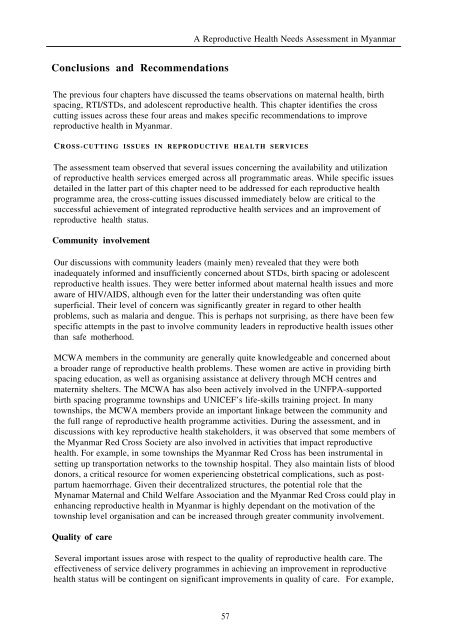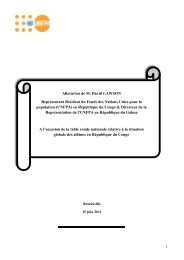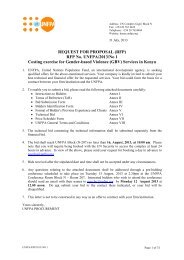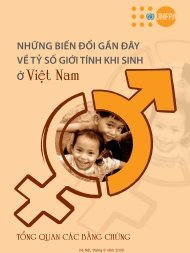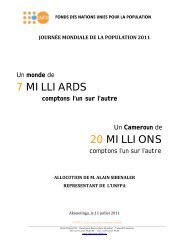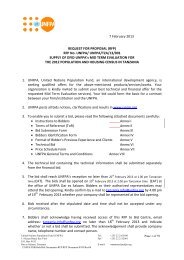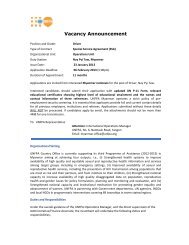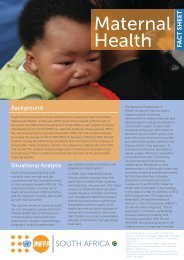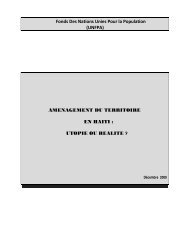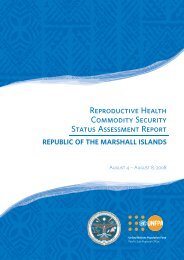A reproductive health needs assessment in Myanmar
A reproductive health needs assessment in Myanmar
A reproductive health needs assessment in Myanmar
Create successful ePaper yourself
Turn your PDF publications into a flip-book with our unique Google optimized e-Paper software.
A Reproductive Health Needs Assessment <strong>in</strong> <strong>Myanmar</strong><br />
Conclusions and Recommendations<br />
The previous four chapters have discussed the teams observations on maternal <strong>health</strong>, birth<br />
spac<strong>in</strong>g, RTI/STDs, and adolescent <strong>reproductive</strong> <strong>health</strong>. This chapter identifies the cross<br />
cutt<strong>in</strong>g issues across these four areas and makes specific recommendations to improve<br />
<strong>reproductive</strong> <strong>health</strong> <strong>in</strong> <strong>Myanmar</strong>.<br />
CROSS-CUTTING ISSUES IN REPRODUCTIVE HEALTH SERVICES<br />
The <strong>assessment</strong> team observed that several issues concern<strong>in</strong>g the availability and utilization<br />
of <strong>reproductive</strong> <strong>health</strong> services emerged across all programmatic areas. While specific issues<br />
detailed <strong>in</strong> the latter part of this chapter need to be addressed for each <strong>reproductive</strong> <strong>health</strong><br />
programme area, the cross-cutt<strong>in</strong>g issues discussed immediately below are critical to the<br />
successful achievement of <strong>in</strong>tegrated <strong>reproductive</strong> <strong>health</strong> services and an improvement of<br />
<strong>reproductive</strong> <strong>health</strong> status.<br />
Community <strong>in</strong>volvement<br />
Our discussions with community leaders (ma<strong>in</strong>ly men) revealed that they were both<br />
<strong>in</strong>adequately <strong>in</strong>formed and <strong>in</strong>sufficiently concerned about STDs, birth spac<strong>in</strong>g or adolescent<br />
<strong>reproductive</strong> <strong>health</strong> issues. They were better <strong>in</strong>formed about maternal <strong>health</strong> issues and more<br />
aware of HIV/AIDS, although even for the latter their understand<strong>in</strong>g was often quite<br />
superficial. Their level of concern was significantly greater <strong>in</strong> regard to other <strong>health</strong><br />
problems, such as malaria and dengue. This is perhaps not surpris<strong>in</strong>g, as there have been few<br />
specific attempts <strong>in</strong> the past to <strong>in</strong>volve community leaders <strong>in</strong> <strong>reproductive</strong> <strong>health</strong> issues other<br />
than safe motherhood.<br />
MCWA members <strong>in</strong> the community are generally quite knowledgeable and concerned about<br />
a broader range of <strong>reproductive</strong> <strong>health</strong> problems. These women are active <strong>in</strong> provid<strong>in</strong>g birth<br />
spac<strong>in</strong>g education, as well as organis<strong>in</strong>g assistance at delivery through MCH centres and<br />
maternity shelters. The MCWA has also been actively <strong>in</strong>volved <strong>in</strong> the UNFPA-supported<br />
birth spac<strong>in</strong>g programme townships and UNICEF’s life-skills tra<strong>in</strong><strong>in</strong>g project. In many<br />
townships, the MCWA members provide an important l<strong>in</strong>kage between the community and<br />
the full range of <strong>reproductive</strong> <strong>health</strong> programme activities. Dur<strong>in</strong>g the <strong>assessment</strong>, and <strong>in</strong><br />
discussions with key <strong>reproductive</strong> <strong>health</strong> stakeholders, it was observed that some members of<br />
the <strong>Myanmar</strong> Red Cross Society are also <strong>in</strong>volved <strong>in</strong> activities that impact <strong>reproductive</strong><br />
<strong>health</strong>. For example, <strong>in</strong> some townships the <strong>Myanmar</strong> Red Cross has been <strong>in</strong>strumental <strong>in</strong><br />
sett<strong>in</strong>g up transportation networks to the township hospital. They also ma<strong>in</strong>ta<strong>in</strong> lists of blood<br />
donors, a critical resource for women experienc<strong>in</strong>g obstetrical complications, such as postpartum<br />
haemorrhage. Given their decentralized structures, the potential role that the<br />
Mynamar Maternal and Child Welfare Association and the <strong>Myanmar</strong> Red Cross could play <strong>in</strong><br />
enhanc<strong>in</strong>g <strong>reproductive</strong> <strong>health</strong> <strong>in</strong> <strong>Myanmar</strong> is highly dependant on the motivation of the<br />
township level organisation and can be <strong>in</strong>creased through greater community <strong>in</strong>volvement.<br />
Quality of care<br />
Several important issues arose with respect to the quality of <strong>reproductive</strong> <strong>health</strong> care. The<br />
effectiveness of service delivery programmes <strong>in</strong> achiev<strong>in</strong>g an improvement <strong>in</strong> <strong>reproductive</strong><br />
<strong>health</strong> status will be cont<strong>in</strong>gent on significant improvements <strong>in</strong> quality of care. For example,<br />
57


